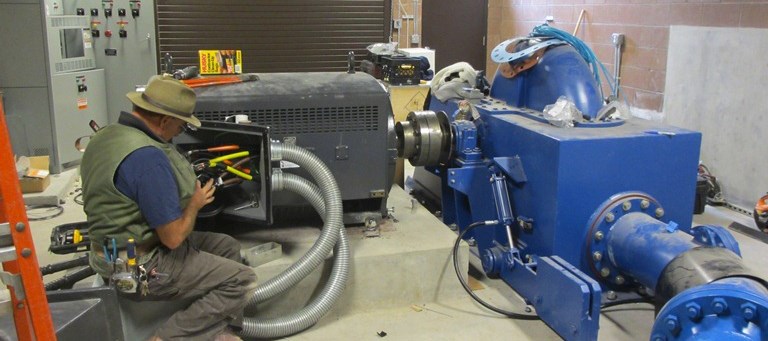Last updated: April 21, 2025
Article
Yellowstone Re-introduces Hydro-electric Power

NPS
One hundred and ten years after the U.S. Calvary installed a turbine in lower Mammoth to provide electricity for Fort Yellowstone the park began generating electricity from water again.
The Mammoth Hot Springs micro-hydro project harnesses energy from the water that flows from the Indian Creek water intake on Swan Lake Flats, to the storage reservoir at Mammoth’s water treatment plant through an existing 12-inch pipe. The elevation change (head) is approximately 450 feet and the volume/flow of water is approximately 4 cubic feet per second. At the inlet to the reservoir, a small building houses the generator, electrical equipment and the new turbine through which the water now flows.
Instead of providing an independent power supply, the equipment is directly synchronized with NorthWestern Energy’s electric grid. This is known as a grid-tie induction generator. Though it is not designed to run independently (and therefore cannot be used as a backup during a power outage), all the electricity generated is added to the overall supply off-setting the park’s energy costs. Because the generator is tied directly into the grid, none of the energy generated is wasted, the generator is not affected by variable loads or overloads, nor are the electrical systems supplied by the generator affected if it isn’t running smoothly or shuts down.
With the most efficient equipment available, the Mammoth micro-hydro consistently generates 175 KW. Though the turbine and generator are capable of 230KW the actual energy generated depends on the water supply: head, pressure and flow. The equipment runs constantly with about 10% down time for maintenance. This equates to 1,379,700 KW hours/year = a saving of approximately $82,782/year in electricity costs! This project was completed in 2013, funded through the American Recovery and Reinvestment Act (ARRA) and cost $1,100,000 to install. The project will pay for itself in 13 years. The micro-hydro unit also saves 900 metric tons of greenhouse gas emissions every year.
